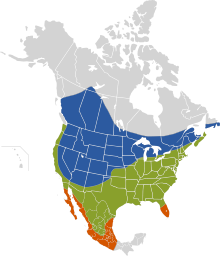Brown-headed cowbird
| Brown-headed cowbird | |
|---|---|
 |
|
| Adult male | |
 |
|
| Adult female | |
| Scientific classification | |
| Kingdom: | Animalia |
| Phylum: | Chordata |
| Class: | Aves |
| Order: | Passeriformes |
| Family: | Icteridae |
| Genus: | Molothrus |
| Species: | M. ater |
| Binomial name | |
|
Molothrus ater (Boddaert, 1783) |
|
 |
|
| Breeding range Year-round range Wintering range | |
The brown-headed cowbird (Molothrus ater) is a small obligate brood parasitic icterid of temperate to subtropical North America. They are permanent residents in the southern parts of their range; northern birds migrate to the southern United States and Mexico in winter, returning to their summer habitat around March or April.
The genus name Molothrus is from Ancient Greek molos, "struggle", and throsko, "to impregnate", and the specific ater is Latin for "dull black". The English name "cowbird", first recorded in 1839, refers to this species often being seen near cattle.
The brown-headed cowbird is typical for an icterid in general shape, but is distinguished by a finch-like head and beak and is smaller than most icterids. The adult male is iridescent black in color with a brown head. The adult female is slightly smaller and is dull grey with a pale throat and very fine streaking on the underparts. The total length is 16–22 cm (6.3–8.7 in) and the average wingspan is 36 cm (14 in). Body mass can range from 30–60 g (1.1–2.1 oz), with females averaging 38.8 g (1.37 oz) against the males' average of 49 g (1.7 oz).
The species lives in open or semi-open country and often travels in flocks, sometimes mixed with red-winged blackbirds (particularly in spring) and bobolinks (particularly in fall), as well as common grackles or European starlings. These birds forage on the ground, often following grazing animals such as horses and cows to catch insects stirred up by the larger animals. They mainly eat seeds and insects.
Before European settlement, the brown-headed cowbird followed bison herds across the prairies. Their parasitic nesting behaviour complemented this nomadic lifestyle. Their numbers expanded with the clearing of forested areas and the introduction of new grazing animals by settlers across North America. Brown-headed cowbirds are now commonly seen at suburban birdfeeders.
...
Wikipedia

